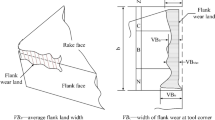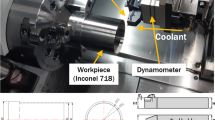Abstract
In the present research, three typical cutting tool wear mechanisms (abrasive wear, adhesive wear, and diffusive wear) were taken into consideration in the FE simulation of cutting tool with a specific user-defined subroutine. Based on the influence of temperature on the cutting tool wear form, a novel wear rate model was built integrating Usui, Takeyama, and Attanasio wear rate equation. The high-speed cutting tests were carried out on Ti6Al4V to determine the proposed wear rate model constant. The cutting forces and rack face wear morphologies obtained from FE simulation match well with those from experimental cutting tests. Finally, the effect of cutting parameters on tool wear was studied by FEM. The simulation results show that the impact of the cutting speed on the cutting tool life is more significant than that of feed rate, and the preferred ranges of cutting speed and feed rate for extending cemented carbide cutting tool in high-speed dry cutting Ti6Al4V are 90–150 m/min and 0.10–0.20 mm/r, respectively.

















Similar content being viewed by others
References
Sartori S, Taccin M, Pavese G, Ghiotti A, Bruschi S (2018) Wear mechanisms of uncoated and coated carbide tools when machining Ti6Al4V using LN2 and cooled N2. Int J Adv Manuf Technol 95:1255–1264
Liu HG, Zhang J, Xua X, Zhao WH (2018) Experimental study on fracture mechanism transformation in chip segmentation of Ti-6Al-4V alloys during high-speed machining. J Mater Process Technol 257:132–140
Wu HB, Zhang SJ (2015) Effects of cutting conditions on the milling process of titanium alloy Ti6Al4V. Int J Adv Manuf Technol 77:2235–2240
Ji CH, Li YH, Qin XD, Zhao Q, Sun D, Jin Y (2015) 3D FEM simulation of helical milling hole process for titanium alloy Ti-6Al-4V. Int J Adv Manuf Technol 81:1733–1742
Rosemar B, Machado ÁR (2013) Tool life and wear mechanisms in high speed machining of Ti–6Al–4V alloy with PCD tools under various coolant pressures. J Mater Process Technol 213:1459–1464
Kaplana B, Odelrosa S, Kritikosa M, Bejjania R, Norgrenab S (2018) Study of tool wear and chemical interaction during machining of Ti6Al4V. Int J Refract Met Hard Mater 72:253–256
Rahman Rashid RA, Palanisamy S, Sun S, Dargusch MS (2016) Tool wear mechanisms involved in crater formation on uncoated carbide tool when machining Ti6Al4V alloy. Int J Adv Manuf Technol 83:1457–1465
Fan YH, Hao ZP, Zheng ML, Yang SC (2016) Wear characteristics of cemented carbide tool in dry-machining Ti-6Al-4V. Mach Sci Technol 20(2):249–261
Yang YF, Su YS, Li L, He N, Zhao W (2015) Performance of cemented carbide tools with microgroove in Ti-6Al-4V titanium alloy cutting. Int J Adv Manuf Technol 76:1731–1738
Costes JP, Guillet Y, Poulachon G, Dessoly M (2007) Tool life and wear mechanisms of CBN tools in machining[J]. Int J Mach Tool Manu 47(7–8):1081–1087
Takeyama H, Murata (1963) Basic investigation of tool wear. J Eng Ind Trans ASME 85(1):33–38
Mathew P (1989) Use of predicted cutting temperatures in determining tool performance. Int J Mach Tool Manu 29(4):481–497
Attanasioa A, Ceretti E, Fiorentino A, Cappellini C, Giardini C (2010) Investigation and FEM-based simulation of tool wear in turning operations with uncoated carbide tools. Wear 269:344–350
Umbrello D, Filice L (2009) Improving surface integrity in orthogonal machining of hardened AISI 52100 steel by modeling white and dark layers formation. CIRP Ann Manuf Technol 58(1):73–76
Buchkremer S, Klocke F, Lung D (2015) Finite-element-analysis of the relationship between chip geometry and stress triaxiality distribution in the chip breakage location of metal cutting operations. Simul Model Pract Theory 55:10–26
Zanger F, Schulze V (2013) Investigations on mechanisms of tool wear in machining ofTi-6Al-4V using FEM simulation. 14th CIRP conference on modeling of machining operations (CIRP CMMO), vol 8, pp 158–163
Altan T, Yen YC, Söhner J, Weule H, Schmidt J (2002) Estimation of tool wear of carbide tool in orthogonal cutting using FEM simulation. In: CIRP Int. workshop on modeling of machining operations, pp 149–160
Attanasio A, Ceretti E, Rizzuti S (2008) 3D finite element analysis of tool wear in machining[J]. CIRP Ann Manuf Technol 57:61–64
Filice L, Micari F, Settineri L, Umbrello D (2007) Wear modelling in mild steel orthogonal cutting when using uncoated carbide tools. Wear 262:545–554
Binder M, Klocke F, Doebbeler B (2017) An advanced numerical approach on tool wear simulation for tool and process design in metal cutting. Simul Model Pract Theory 70:65–82
Fleischer J, Schmidt J, Xie L J, Schmidt C, Biesinger F (2004) 2D tool wear estimation using finite element method. In: Moisan A, Poulachon G (eds) Proceedings of the seventh CIRP international workshop on modeling of machining operations, Cluny, pp 82–91
Yen YC, Söhner J, Lilly B, Altan T (2004) Estimation of tool wear in orthogonal cutting using the finite element analysis. J Mater Process Technol 146:82–91
Kalhori V (2001) Modelling and simulation of mechanical cutting. PH.D thesis, The Polhem Laboratory Division of Computer Aided Design Department of Mechanical Engineering, Sweden
Chetan A, Narasimhulu S, Ghosh P, Rao V (2015) Study of tool wear mechanisms and mathematical modeling of flank wear during machining of Ti alloy (Ti6Al4V). J Inst Eng (India) 96(3):279–285
Cao ZY, He N, Li L (2008) A finite element analysis of micromeso-scale machining considering the cutting edge radius. Appl Mech Mater 11(12):631–636
Usui E, Shirakashi T (1984) Analytical prediction of cutting tool wear. Wear 100:129–151
Abukhshim NA, Mativenga PT, Sheikh MA (2006) Heat generation and temperature prediction in metal cutting: a review and implications for high speed machining. Int J Mach Tool Manu 46(7–8):782–800
Funding
The authors gratefully acknowledge the financial supports of the National Natural Science Foundation of China (No. 51275231), the Anhui Provincial Natural Science Foundation (NO. 1608085ME121), and Nanjing University of Aeronautics and Astronautics PhD short-term visiting scholar project (No. 190304DF06).
Author information
Authors and Affiliations
Corresponding author
Additional information
Publisher’s note
Springer Nature remains neutral with regard to jurisdictional claims in published maps and institutional affiliations.
Rights and permissions
About this article
Cite this article
Wang, Y., Su, H., Dai, J. et al. A novel finite element method for the wear analysis of cemented carbide tool during high speed cutting Ti6Al4V process. Int J Adv Manuf Technol 103, 2795–2807 (2019). https://doi.org/10.1007/s00170-019-03776-1
Received:
Accepted:
Published:
Issue Date:
DOI: https://doi.org/10.1007/s00170-019-03776-1




